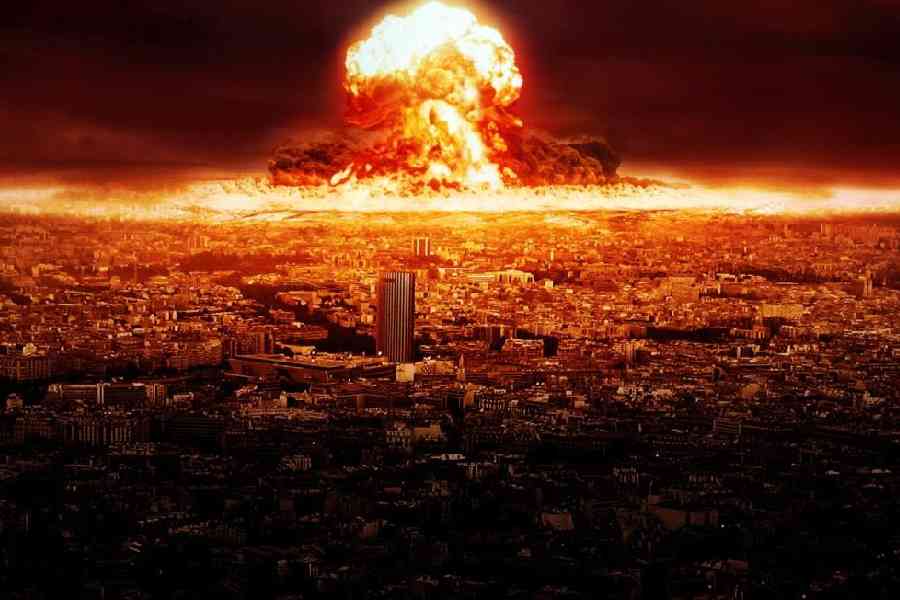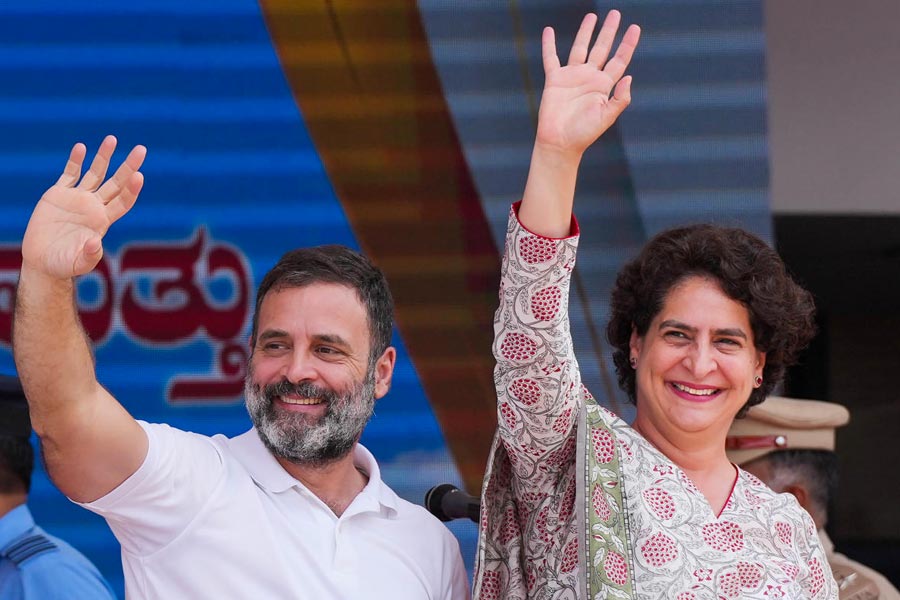Twenty-five years ago, in the month of May in 1998, India conducted five nuclear bomb test explosions at the Indian army’s Pokhran Test Range. They are known as Pokhran II. The first of these, on 11 May, coincided with Buddha Jayanti.
That was bizarre.
Could the Great Indian Establishment, then headed by Prime Minister Atal Bihari Vajpayee, not have avoided that date?
Bombs and the Buddha do not go together.
But why should it have avoided that date? After all, the very first such test, known now as Pokhran I, was also conducted on Buddha Jayanti — May 18, 1974. More, it was codenamed by the Great Indian Establishment of the day headed by Prime Minister Indira Gandhi as Smiling Buddha.
If the daughter of Jawaharlal Nehru, an ardent admirer of the Buddha, did not have the sensitivity to see the incongruity of conducting a nuclear test on Buddha Jayanti, then there is no reason why Atalji should have worried about the coincidence of his Pokhran tests and Buddha Jayanti.
Atalji was, if anything, more honest. He spoke the truth about the test. He did not say that it was a peaceful device that had been exploded. He knew it to be and had it described as what it was: a nuclear bomb tested successfully.
And the country as a whole celebrated the achievement. Our embassies abroad and the Indian diaspora generally were elated. ‘We can now hold our heads high’ was the sentiment underlying the euphoria.
I was working then for the president of India, the wise and brave K.R. Narayanan, as his secretary. I knew he was in favour of India going nuclear. That was his considered belief and I could only respect it in the position of a seasoned diplomat and scholar of international affairs. He was reading some official papers seated in the Mughal Gardens when I went to him with the news of the test as conveyed over the phone to me by Mr Brajesh Mishra, the national security adviser. That incredibly able diplomat and strategist had apprised President Narayanan earlier, in complete confidence, about the intended tests. So, this news was not unexpected.
Nonetheless, the president was visibly pleased and straightaway wrote out a statement: “This event is a major breakthrough in the realm of national security. I extend my felicitations to all the scientists and technologists who have made this possible and say to them — India is proud of you.” The Opposition Congress hailed the event as “… a national achievement of which the nation is proud.” The former prime ministers, I.K. Gujral and Deve Gowda, too, lauded the tests.
After the news had become official, I rang a cherished friend of mine and said, “We have burst the crackers…” Shocked, he said, “No! No!” I went later that evening with him and my wife to the sublime Buddha shrine adjacent to the Lakshminarayan Temple, better known as Birla Mandir, on New Delhi’s Reading Road for a few moments of quiet reflection. I could, of course, see the Buddha smiling but it was a curious smile that seemed to say, ‘Mankind is bent on suicide; yet some will strive with diligence to draw it away from that path.’
Way back in 1957, a British Quaker called Harold Steele had come to India to get a ship that he could sail in to get to the Pacific Islands to be blown into smithereens. Blown up? Precisely that, under hydrogen bombs that Britain was testing there. Steele with others minded like him were appalled that this should be done, unmindful of the radiation to which the tests would subject humans to in that zone. I sat in during a meeting Steele had with my father, a newspaper editor at the time. What was discussed, I cannot remember but Steele’s clean-cut face and his determined jaw made an impression on my eleven-year-old mind that has not gone away. Steele’s mission came to naught due to lack of funds and official obstruction but I was not surprised to read much later that Steele had, apart from meeting my father, been received by Nehru in New Delhi. Steele was to record: “Mr. Nehru wished me well and his whole bearing and attitude of speech showed he was not opposed to my mission.”
Nic Maclellan in a study of Steele has this to say: “Harold Steele’s dream of sailing a boat into the middle of the Pacific nuclear test zone went unfulfilled, but his vision inspired many others. In 1958, US pacifist Albert Bigelow planned to sail the Golden Rule from California to Enewetak Atoll in the Marshall Islands, to disrupt the US military’s test series codenamed Operation Hardtack. When Bigelow’s yacht was seized by the US Coast Guard off Hawai’i, a former US naval officer Earle Reynolds took up his voyage, and sailed the yacht Phoenix to waters off Bikini Atoll. Reynolds, his wife Barbara and children later sailed to the USSR to protest against Soviet nuclear testing.
‘More than a decade later, the rusting fishing trawler Phyllis Cormack was renamed the Greenpeace, and sailed from Vancouver in 1971 attempting to halt US nuclear tests in the northern Pacific. Greenpeace activists and other mariners aboard the Vega, Fri, Rainbow Warrior and other vessels bedevilled the French state in the waters off Moruroa Atoll until France’s nuclear testing program ended in 1996… Harold Steele’s tradition of moral witness and ‘bodies on the line’ had taken root in the Pacific — a lesson learnt by a new generation of climate activists.”
Today, one does not hear voices from civil society talking of the nuclear threat or, for that matter, of biological and chemical threats to the world. Disarmament is a piety in conference agendas. And, of course, there is no voice from the world of scientists and physicists anywhere near that of J.R. Oppenheimer, Kenneth Bainbridge, Bertrand Russell and Albert Einstein or Joseph Rotblat, the leading light of the Pugwash Movement, who warned the world of the peril of a nuclear pile-up, in the great Russell-Einstein Manifesto of July 5, 1955. (The Pugwash Conferences on Science and World Affairs sought to work to reduce the danger of armed conflict.)
The risks of nuclear devastation caused by war or terror or error as outlined by Martin Rees, the great astrophysicist, are one great exception. Speaking about his book, The Final Century, Rees says: “…[W]e have to go back to what happened in the post-War era, post-World War II, when the nuclear scientists who’d been involved in making the atomic bomb in many cases were concerned that they should do all they could to alert the world to the dangers. And they were inspired not by the young Einstein, who did the great work in relativity, but by the old Einstein, the icon of poster and t-shirt, who failed in his scientific efforts to unify the physical laws. He was premature. But he was a moral compass — inspiration to scientists who were concerned with arms control.”
On this twenty-fifth anniversary of Pokhran II, some contrarians amongst us might think why today, when the risks of mass extinction are far, far greater, the moral compasses amidst us to warn of those are so much fewer. Why should we have Pokhran after Pokhran in India but not one Pugwash? The scientists that were identified as having made India proud are known. But are there any among that community who can claim to be of the Einstein, Russell, Rotblat league? For the record, it must be said that Professor M.S. Swaminathan lent distinction to the Pugwash body by serving on it.
The Buddha in our history now embodies dukkha in the shape of the ground quaking from nuclear explosion after nuclear explosion. Agni is not the ancient fire god who sanctifies, but a missile. Prithvi not Mother Earth, but also a missile. In a park that I regularly walk in are some of the finest botanical specimens one can find anywhere. Also, replicas of these missiles. And tanks. No one notices the trees. Everyone flocks around the missiles and the tanks. Especially children, whose parents then take pictures of them saluting the war machines.
Will any of them ever get to hear of Indian opposition to war? Of Indian protests for peace? It is not as if there are no brave-hearts who wage that war on war and fight that peaceful fight for peace. But they are few and are not taken seriously.
Nuclear, biological, chemical and cyber weapons further fortified by the as yet only dimly perceived risks of Artificial Intelligence can unleash misery upon us.
Grim as this prognosis is, the Buddha at Birla Mandir saying through a curious smile ‘... some will strive...’ makes me believe that individuals, including scientists in Japan and Germany (countries which were placed under war constraints after World War II), South Africa (which reversed its nuclear weaponisation programme) and India, will pioneer an initiative towards comprehensive disarmament.










